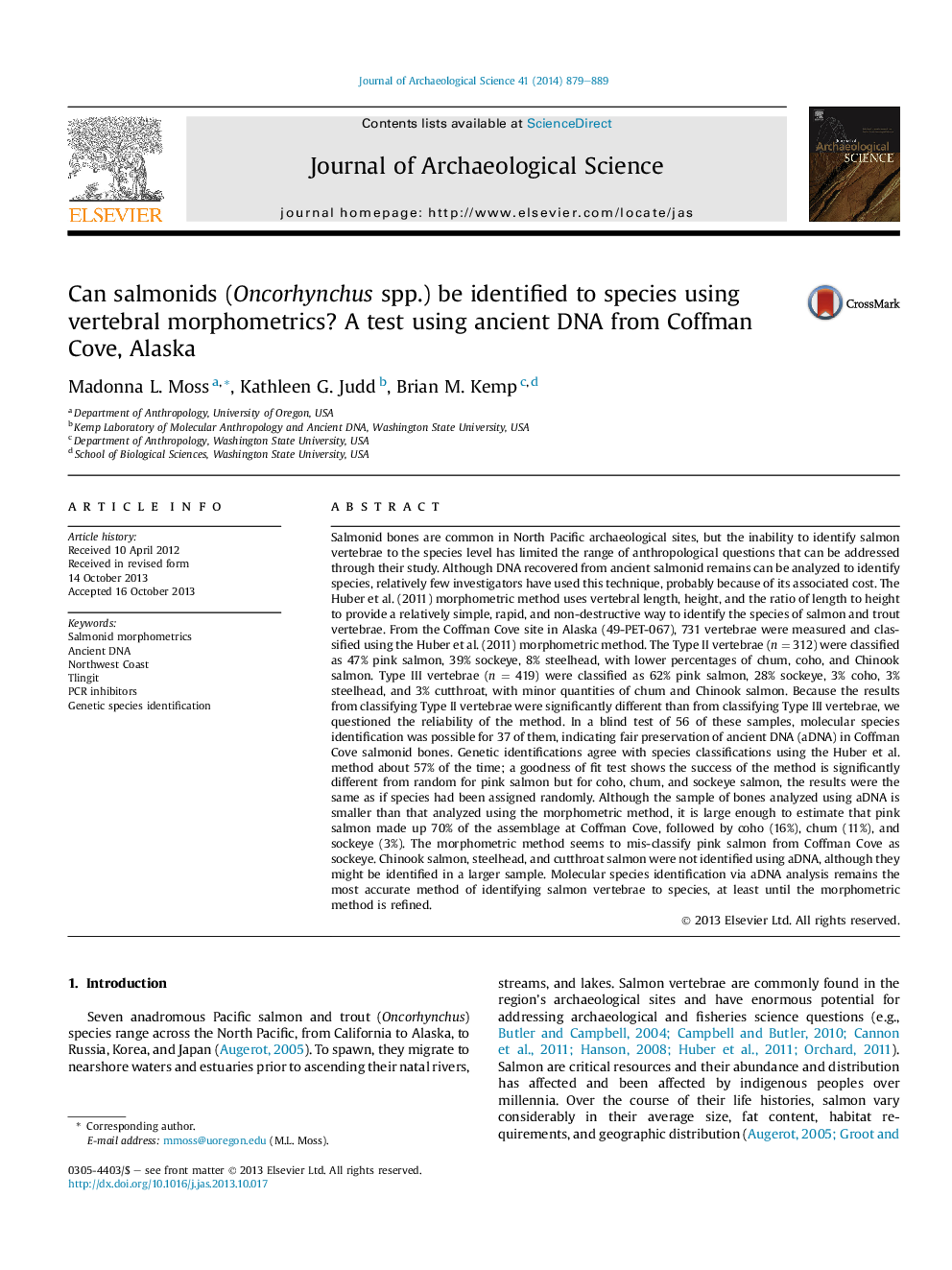| کد مقاله | کد نشریه | سال انتشار | مقاله انگلیسی | نسخه تمام متن |
|---|---|---|---|---|
| 7444229 | 1483919 | 2014 | 11 صفحه PDF | دانلود رایگان |
عنوان انگلیسی مقاله ISI
Can salmonids (Oncorhynchus spp.) be identified to species using vertebral morphometrics? A test using ancient DNA from Coffman Cove, Alaska
دانلود مقاله + سفارش ترجمه
دانلود مقاله ISI انگلیسی
رایگان برای ایرانیان
کلمات کلیدی
موضوعات مرتبط
مهندسی و علوم پایه
مهندسی مواد
دانش مواد (عمومی)
پیش نمایش صفحه اول مقاله

چکیده انگلیسی
Salmonid bones are common in North Pacific archaeological sites, but the inability to identify salmon vertebrae to the species level has limited the range of anthropological questions that can be addressed through their study. Although DNA recovered from ancient salmonid remains can be analyzed to identify species, relatively few investigators have used this technique, probably because of its associated cost. The Huber et al. (2011) morphometric method uses vertebral length, height, and the ratio of length to height to provide a relatively simple, rapid, and non-destructive way to identify the species of salmon and trout vertebrae. From the Coffman Cove site in Alaska (49-PET-067), 731 vertebrae were measured and classified using the Huber et al. (2011) morphometric method. The Type II vertebrae (n = 312) were classified as 47% pink salmon, 39% sockeye, 8% steelhead, with lower percentages of chum, coho, and Chinook salmon. Type III vertebrae (n = 419) were classified as 62% pink salmon, 28% sockeye, 3% coho, 3% steelhead, and 3% cutthroat, with minor quantities of chum and Chinook salmon. Because the results from classifying Type II vertebrae were significantly different than from classifying Type III vertebrae, we questioned the reliability of the method. In a blind test of 56 of these samples, molecular species identification was possible for 37 of them, indicating fair preservation of ancient DNA (aDNA) in Coffman Cove salmonid bones. Genetic identifications agree with species classifications using the Huber et al. method about 57% of the time; a goodness of fit test shows the success of the method is significantly different from random for pink salmon but for coho, chum, and sockeye salmon, the results were the same as if species had been assigned randomly. Although the sample of bones analyzed using aDNA is smaller than that analyzed using the morphometric method, it is large enough to estimate that pink salmon made up 70% of the assemblage at Coffman Cove, followed by coho (16%), chum (11%), and sockeye (3%). The morphometric method seems to mis-classify pink salmon from Coffman Cove as sockeye. Chinook salmon, steelhead, and cutthroat salmon were not identified using aDNA, although they might be identified in a larger sample. Molecular species identification via aDNA analysis remains the most accurate method of identifying salmon vertebrae to species, at least until the morphometric method is refined.
ناشر
Database: Elsevier - ScienceDirect (ساینس دایرکت)
Journal: Journal of Archaeological Science - Volume 41, January 2014, Pages 879-889
Journal: Journal of Archaeological Science - Volume 41, January 2014, Pages 879-889
نویسندگان
Madonna L. Moss, Kathleen G. Judd, Brian M. Kemp,